Stability of LDO Loop and Its Influence on RF Synchronous Phase Noise
Summary
Phase noise is one of the most important technical indicators for clock and RF frequency synthesis. There are many factors that affect the phase-locked loop phase noise, such as power supply, reference source phase noise, VCO's own phase noise, and loop filter settings. Among them, the low frequency noise introduced by the power supply often has a great influence on the near phase noise of the phase locked loop. For high performance clock and RF multiplex products, low noise LDOs are often used to achieve very low phase noise performance. However, using different LDOs to power the frequency synthesizer, the phase noise performance obtained will often be very different. At the same time, the LDO peripheral circuit design will also affect the phase noise performance of the frequency synthesizer.
This paper first briefly introduces the noise source of LDO and the influence of loop stability on output noise. Secondly, the theoretical calculation relationship between phase noise of VCO and noise spectral density of LDO is derived according to the frequency modulation theory. On this basis, in order to verify the influence of LDO noise on the phase noise of the RF frequency synthesizer output, the TPS7A8101 and TPS74401 LDO evaluation boards are used to supply power to the TRF3765 RF frequency comprehensive evaluation board, and the TRF3765 phase noise curves of the two cases are compared and tested. In order to verify the influence of LDO loop stability on the frequency-compound phase noise, the reference circuit of the TPS7A8101 evaluation board was partially modified, and the phase noise of the TRF3765 output before and after the circuit modification was compared.
1. The influence of LDO noise source and loop stability on output noise
1.1 LDO noise source
The noise of the LDO is divided into noise inside the LDO and noise outside the LDO. The noise inside the LDO comes from the bandgap reference of the internal circuit, the amplifier and the transistor. The noise outside the LDO comes from the input. In the LDO manual, PSRR is a measure of the ability of an LDO to reject external noise, but a high PSRR does not mean that the internal noise of the LDO is small. The total output noise of the LDO is the parameter that characterizes the internal noise suppression of the LDO. Is it generally used in the electrical characteristics table? VRMS means, or is represented on the noise spectral density map.
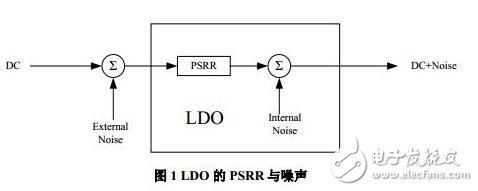
Figure 2 is a block diagram of the internal structure of the LDO, and VN represents the equivalent noise source. Noise sources include noise VN (REF) from the bandgap reference, noise VN (AMP) from the error amplifier, noise VN (FET) from the FET, and noise VN (R1) and VN (R2) from the feedback resistor. In most cases, since the bandgap reference source circuit is composed of many different resistors, transistors, and capacitors, it produces much more noise than the feedback resistor. Moreover, the bandgap reference is the input of the error amplifier, and the noise generated by it is also controlled by the error amplifier to control the FET, so the error amplifier itself and the noise generated by the FET are also lower than the noise of the bandgap reference. It can be said that the largest noise source inside the LDO is the bandgap reference source. We denote the LDO output noise VN (OUT) as

VN (Other) is the sum of VN (AMP) and VN (FET). It can be concluded from Equation 1 that the minimum value of the output noise occurs when R1 is shorted to FB and the gain of the error amplifier is approximately 1.
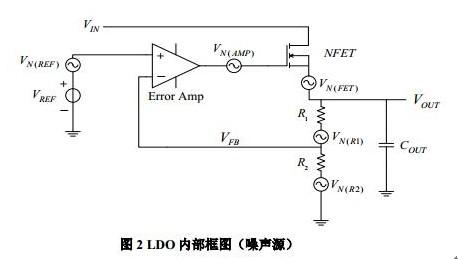
1.2 LDO noise suppression method
There are three ways to suppress the noise generated by the bandgap reference.
One is to reduce the bandwidth of the error amplifier and suppress the high frequency noise of the bandgap reference. However, reducing the bandwidth will degrade the dynamic performance of the LDO.
The second is to add low-pass filtering between the bandgap reference and the error amplifier. High-performance LDOs have a noise-suppressed NR pin that is connected in parallel between the bandgap reference and GND for low-pass filtering. As shown in Figure 3.
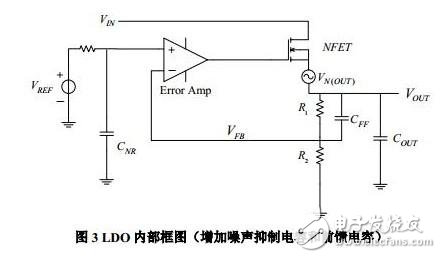
The third is to increase the feedforward capacitor CFF on the feedback resistor R1. After adding CFF and CNR, the output noise can be expressed as

It can be concluded from Equation 2 that the larger the CFF, the smaller the output noise. The higher the frequency, the smaller the output noise.
Figure 4 is a plot of noise spectral density at different CFFs. It can be seen that the larger the CFF, the better the noise can be suppressed from the low frequency. When CFF is too small, the effect of suppressing noise is less obvious. When the frequency is high, no matter how much CFF is used, the noise spectral density will not be too different. Therefore, adding a suitable feedforward capacitor CFF has a very good effect on improving LDO low frequency noise.
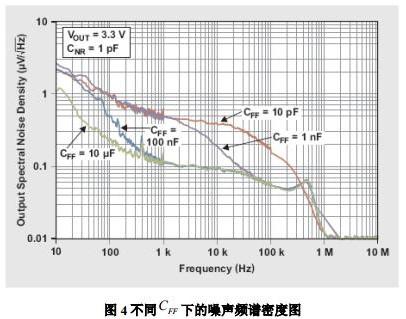
1.3 Relationship between LDO loop stability and output noise
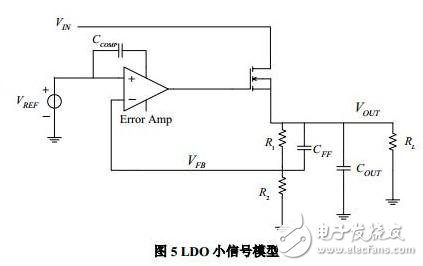
It can be seen from the LDO small-signal analysis that the LDO has two low-frequency poles. If there is no suitable zero-point compensation, the stability margin of the LDO is not enough, and oscillation may occur. LDOs with insufficient stability margins generate more internal noise. The third noise suppression method mentioned in the previous section is that increasing the feedforward capacitor CFF is actually to improve the system stability margin. A low frequency zero is formed by CFF and R1.  .
.
As can be seen from the frequency response in the figure below, the zero point has a large increase in phase margin, which increases the stability of the system and thus reduces the low frequency noise of the system.
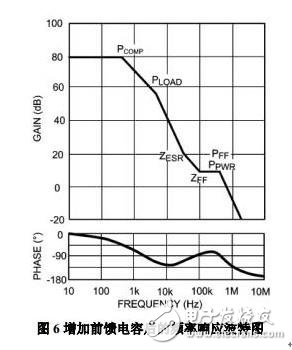
The Tv Mobile Stand series includes many types of TV stand which are widely use for large size (70~120") TVs, it with firm struction and loading weight up to 660 pounds, the slim new type TV Mobile Stand passed UL approval yet.
TV Mobile Stand
Rolling Tv Stand,Tv Mobile Stand,Heavy Duty Rolling Tv Stand,Mobile Tv Stand With Wheels
Foshan Dinghan Electrical Technology Co., Ltd , https://www.dinghanelectrical.com